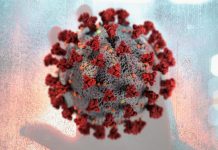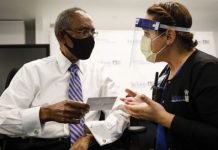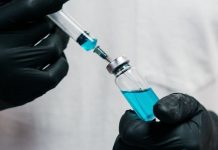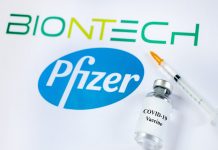All data and statistics are based on publicly available data at the time of publication. Some information may be out of date. Visit our coronavirus hub and follow our live updates page for the most recent information on the COVID-19 pandemic.
The Food and Drug Administration (FDA) has expanded its list of hand sanitizers the agency says consumers should avoid.
The agency now lists 75 hand sanitizers it says are tainted with methanol. Some of the products have already been recalled.
The hand sanitizers include brands sold at Sam’s Club and BJ’s Wholesale Club.
In late June, the agency issued a warning against purchasing and using nine hand sanitizer brandsTrusted Source made in Mexico.
Agency officials said the hand sanitizers contained as much as 81 percent toxic methanol, also known as wood alcohol. The chemical can cause blindness and death if ingested.
“Methanol can dehydrate the skin, causing dry skin, and can result in dermatitis to the affected region. The main problem with methanol is that it is absorbed through the skin and can result in toxic levels of this chemical,” Dr. Michael Dannenberg, the chair of dermatology at Huntington Hospital in Pasadena, California, told Healthline.
“Methanol toxicity can result from ingesting or from absorption through the lungs (i.e., inhaling the methanol fumes) or absorption through the skin. Absorption through the skin can be a problem for anyone, but young children are at the highest risk of this,” he said.
SymptomsTrusted Source of methanol poisoning include nausea, vomiting, dizziness, headaches, weakness, visual disturbances, and loss of consciousness.
The fumes from methanol are also flammable, another potential danger.
Here are the original nine brands the FDA warns against. Two of them have the same name but different lot numbers:
- All-Clean Hand Sanitizer
- Esk Biochem Hand Sanitizer
- CleanCare NoGerm Advanced Hand Sanitizer 75% Alcohol
- Lavar 70 Gel Hand Sanitizer
- The Good Gel Antibacterial Gel Hand Sanitizer
- CleanCare NoGerm Advanced Hand Sanitizer 75% Alcohol
- CleanCare NoGerm Advanced Hand Sanitizer 80% Alcohol (lot number 74589-005-03)
- CleanCare NoGerm Advanced Hand Sanitizer 80% Alcohol (lot number 74589-003-01)
- Saniderm Advanced Hand Sanitizer
If you do have one of these items in your home, stop using them immediately and dispose of them, but don’t flush or pour the products down the drain, the FDA says.
Instead, “dispose of them immediately in appropriate hazardous waste containers,” the agency recommends.
The importance of hand sanitizer safety was highlighted in data released in late July.
The American Association of Poison Control Centers reports that there has been a 59 percent increase in the number of hand sanitizer exposure cases reported to poison control centers so far this year.
The overwhelming majority of those cases involve children under 6 years of age.
Sanitizer saturation
As the COVID-19 pandemic has swept the United States — now an epicenter of the outbreak and worldwide leader in cases — demand for virus-killing hand sanitizer has grown exponentially.
That demand led the FDA to relax rules on the manufacture of hand sanitizer, allowing an additional 1,500 manufacturers of sanitizer joining the market.
Critics have warned that this relaxation of the rules could lead to problems with oversight and product safety.
“Unfortunately, this product [All-Clean Hand Sanitizer] was labeled ‘FDA approved,’ and that can be misleading,” said Jessica Ruiz, RN, MSN, NEA-BC, director of strategic products at Stonegate Pharmacies in Austin, Texas.
“FDA publishes product listing information provided by the companies that make the drug on the National Drug Code (NDC) directory, but this listing does not mean the drug is approved by the FDA,” she said. “Anyone can look up a drug product and download the information by searching on the NDC for the term ‘hand sanitizer.’”
Ruiz told Healthline that the FDA had taken the step of specifically asking manufacturersTrusted Source to denature alcohol — which makes it smell and taste bad to help prevent young children from wanting to ingest it — and limit harmful impurities like methanol to safe levels.
But those recommendations are nonbinding, the agency states.
How to spot safe hand sanitizer
So, how can consumers be sure the hand sanitizer they pick up at the store is safe?
The number one thing is to “go to the brands you trust and rely on, like Touchland, Purell, etc.,” Dr. Dendy Engelman, director of dermatologic surgery at Metropolitan Hospital in New York City, told Healthline.
Engelman also recommends looking at ingredient labels to make sure they have ethanol/ethyl alcohol or isopropyl/isopropanol as their active ingredient.
The Centers for Disease Control and Prevention (CDC)Trusted Source recommends at least 60 percent ethanol and 70 percent isopropanol.
The FDA takes an even more stringent approach, recommending hand sanitizers be at least 94.9 percent ethanol by volume.
But as the FDA warning indicates, labels may not be enough to ensure safety.
“Until further notice, I would recommend avoiding all Mexican-produced hand sanitizers,” Dannenberg said. “In addition, the active chemical in hand sanitizers should be ‘ethyl alcohol.’ If the product simply lists alcohol, I would avoid it.”
SOURCE: Healthline
LINK: https://www.healthline.com/health-news/fda-says-avoid-9-hand-sanitizers-that-contain-toxic-methanol#How-to-spot-safe-hand-sanitizer







